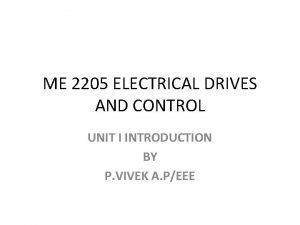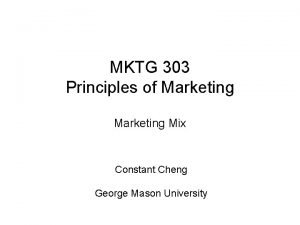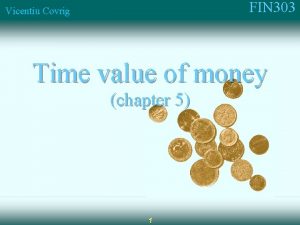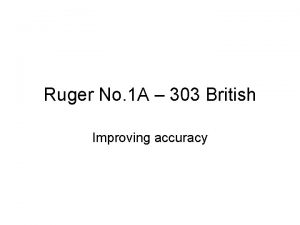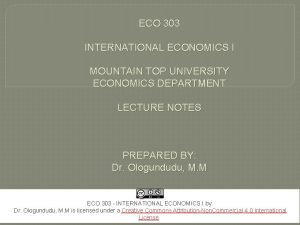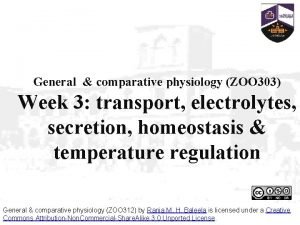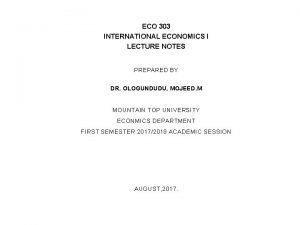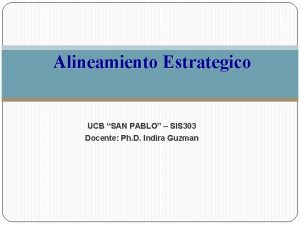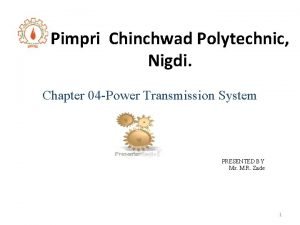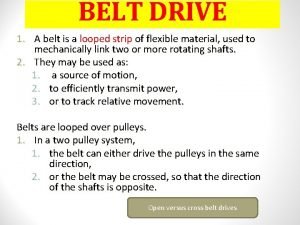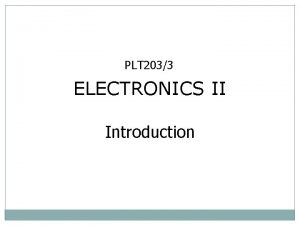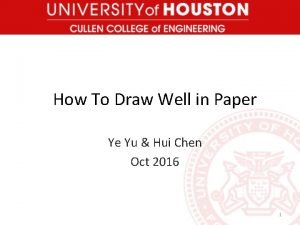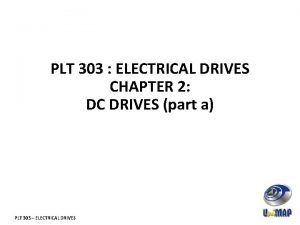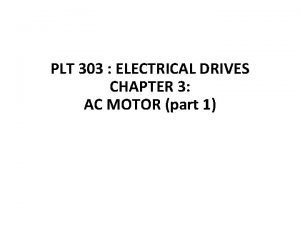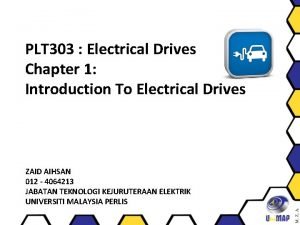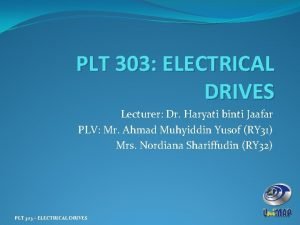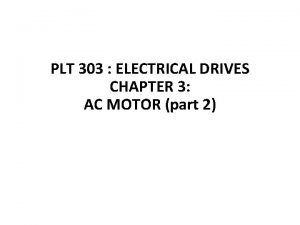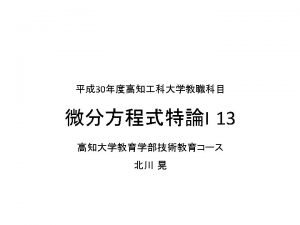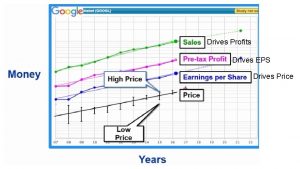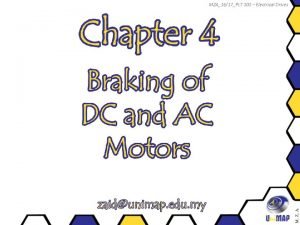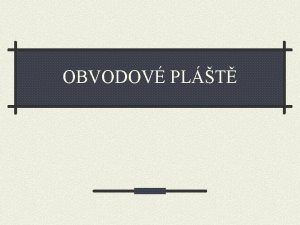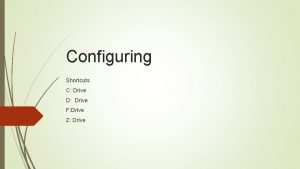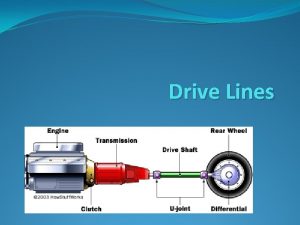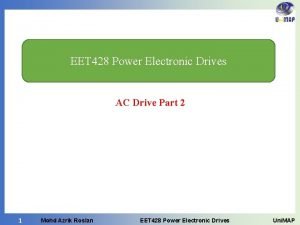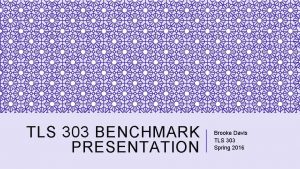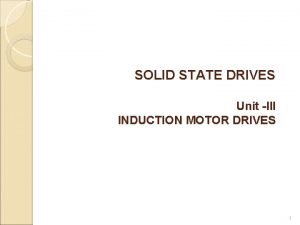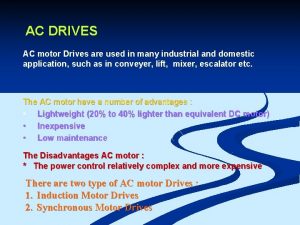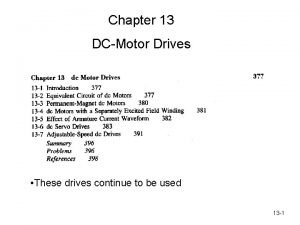PLT 303 ELECTRICAL DRIVES AC Drive Part 13


































- Slides: 34

PLT 303 ELECTRICAL DRIVES AC Drive Part 1/3 Zaid Aihsan 1

What to learn in this topic v. Drive classification v. Drive configuration v. Load characteristic v. Basic Principles of AC Drive Controls ØUsing rotor resistance ØUsing adjusting stator voltage ØUsing supply frequency ØUsing both supply voltage and frequency ØUsing rotor voltage injection ØUsing slip energy recovery 2

Drive Classification PLT 303 – Electrical Drives 3

Drive comparison 4

PWM Classification 5

Reduction of supply harmonics 6

Drive configuration 7

Drive configuration PLT 303 – Electrical Drives 8

Drive configuration : Feature 9

Drive configuration : Feature cont 10

Load characteristic 11

Basic Principles of AC Drive Controls v. The speed, ω (or slip, s) can be controlled using: ØArmature or rotor resistance Ømagnitude of terminal voltage (stator voltage) Øfrequency of terminal voltage (supply frequency) Øvoltage / frequency control Ørotor voltage injection Øslip energy recovery 12

Using Rotor Resistance v. Using steady state operation (small slip) analysis, the torque equation can be simplified to: v. If the voltage, frequency and torque are kept constant; increase in R’ 2 results an increase in slip thus motor speed is reduced. v. Adding a resistance, R’add to the rotor circuit does not change the synchronous speed or the magnitude of the maximum torque but it changes the torque-speed characteristic so that the maximum torque occurs at lower speed. 13

Using Rotor Resistance (cont’d) v. At light loading conditions (point 1 and point 2), the difference in speed is rather small. v. At heavy loading conditions (point 3 and point 4), the motor speed may change by a wider range v. Drawback Øit increases motor losses 14

Using Rotor Resistance (cont’d) v Example 1: A 3 -phase, Y-connected, 30 Hp (rated output), 480 V phase, 6 -poles, 60 Hz slip ring induction motor has resistance of R 1 = 0. 5 Ω and R’ 2 = 0. 5 Ω. The rotational losses are 500 W and the core losses are 600 W. Assume that the load torque is constant and the change in rotational losses due to the change in speed is minor. Calculate: a) the speed of the motor at full load. b) the R’add needed to reduced the speed by 20%. c) the motor efficiency with and without R’add. 15

Using Rotor Resistance (cont’d) v Example 1 Solution a) the speed of the motor at full load. Speed, rpm 16

Using Rotor Resistance (cont’d) v Example 1 Solution a) the speed of the motor at full load. Speed, rpm 17

Using Rotor Resistance (cont’d) v Example 1 Solution a) the speed of the motor at full load. Speed, rpm 18

Using Rotor Resistance (cont’d) v Example 1 Solution b) the R’add needed to reduced the speed by 20%. Additional resistor, R’ add Speed reduce 20 % = 80 % performance 19

Using Rotor Resistance (cont’d) v Example 1 Solution b) the R’add needed to reduced the speed by 20%. Additional resistor, R’ add Speed reduce 20 % = 80 % performance 20

Using Rotor Resistance (cont’d) v Example 1 Solution c) the motor efficiency with and without R’add. Efficiency, 21

Using Rotor Resistance (cont’d) v Example 1 Solution c) the motor efficiency with and without R’add. Efficiency, Without R’add 22

Using Rotor Resistance (cont’d) v Example 1 Solution c) the motor efficiency with and without R’add. Efficiency, 23

Using Rotor Resistance (cont’d) v Example 1 Solution c) the motor efficiency with and without R’add. Efficiency, 24

Using Rotor Resistance (cont’d) v Example 1 Solution c) the motor efficiency with and without R’add. Efficiency, With R’add Since torque is constant 25

Using Rotor Resistance (cont’d) v. Example 1 Solution c) the motor efficiency with and without R’add. Efficiency, With R’add 26

Using Rotor Resistance (cont’d) v Example 1 Solution c) the motor efficiency with and without R’add. Efficiency, With R’add 27

Using Rotor Resistance (cont’d) v Example 1 Solution c) the motor efficiency with and without R’add. Efficiency, With R’add 28

Using Rotor Resistance (cont’d) v. Example 1 Solution c) the motor efficiency with and without R’add. Efficiency, With R’add 29

Adjusting the Stator Voltage v. For the same slip and frequency, a small change in motor voltage results in a relatively large change in torque. v. A 10% reduction in voltage causes a 19% reduction in develop torque as well as the starting and maximum torque. v. It is an excellent method for reducing starting current and increasing efficiency during light loading conditions. v. Core losses are reduced v. Only suitable for speed reduction below the rated speed. 30

Adjusting the Stator Voltage (cont’d) v Example 2: A 3 -phase, Y-connected, 20 Hp, 415 V, 4 -poles, 50 Hz slip ring induction motor has resistance of R 1 = 0. 5 Ω and R’ 2 = 0. 55 Ω. Assume the load torque is constant and equal to 100 Nm. Ignore the rotational losses. Calculate: a) the motor speed at full voltage. b) the motor speed if the voltage is reduced by 20%. 31

Adjusting the Stator Voltage (cont’d) v. Example 2 Solution a) the speed of the motor at full load. Speed, rpm 32

Adjusting the Stator Voltage (cont’d) v. Example 2 Solution a) the speed of the motor at full load. Speed, rpm 33

Adjusting the Stator Voltage (cont’d) v. Example 2 Solution b) the motor speed if the voltage is reduced by 20% Speed, rpm Speed reduced by 20% which equal to 80% performance. 34
 Https drive google com drive u 1 shared with me
Https drive google com drive u 1 shared with me Ebhttps://www.google.com
Ebhttps://www.google.com Google classroom
Google classroom Electrical drives and control
Electrical drives and control Dywizjon 303 klp
Dywizjon 303 klp Emin gun sirer
Emin gun sirer Cheng, constant
Cheng, constant Fin 303
Fin 303 Kin 303
Kin 303 3 6 9 12 15 18 21 24 27 30
3 6 9 12 15 18 21 24 27 30 Ruger no 1 accuracy
Ruger no 1 accuracy Bilişi yönetme
Bilişi yönetme Explain kravis and linder theory
Explain kravis and linder theory 38cfr3.303
38cfr3.303 Form uib-290
Form uib-290 Zool 303
Zool 303 Cse 303
Cse 303 Eco 303
Eco 303 Vir 303
Vir 303 303-318-9014
303-318-9014 Sis-303
Sis-303 Https drive google com drive u 0 recent
Https drive google com drive u 0 recent 1https://drive.google.com/drive/u/1
1https://drive.google.com/drive/u/1 Https://drive.google.com/drive/
Https://drive.google.com/drive/ Difference between open belt drive and cross belt drive
Difference between open belt drive and cross belt drive Crossed belt drive
Crossed belt drive Plt skills
Plt skills Al culture
Al culture Fcps my plt
Fcps my plt Plt morphology
Plt morphology Distribuzione volumetrica plt
Distribuzione volumetrica plt Plt electronics
Plt electronics How to draw an ye
How to draw an ye Plt skills
Plt skills Plt cbc
Plt cbc



